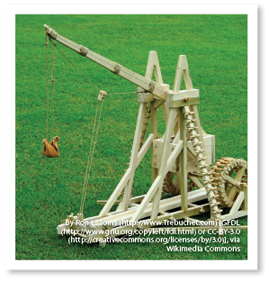36
Applying
Applying something means putting it to work in a specific situation. By creatively applying an idea, you can discover new possibilities and solutions.
Square-Pegging
You’ve heard the expression of putting a square peg in a round hole. Usually, that solution is not preferred; but by forcing something to be used in a novel way, you can come up with many new ideas. Create a square-peg question by using the following formula. Then answer the questions in as many ways as you can.

How can a rowboat win an election?
- Take the political race to a desert island.
- Let your candidate use the boat to reenact Washington crossing the Potomac.
- Use the boat to ferry in disenfranchised voters.
- Use the boat to bring absentee ballots to voters.
- Show that the boat is smarter than other candidates.
- Make the rowboat a symbol—saved from the sinking ship.
Your Turn Create a square-peg question of your own. Ask how your topic can do something it was not intended to do. Answer the question in as many ways as you can.
Modeling
 Modeling an idea means expressing it in a conceptual form. You can model something by sketching it, molding it from clay, building a prototype or scale model, graphing it, creating an equation, or expressing it in some other form. The image to the right shows a working scale model of a medieval trebuchet.
Modeling an idea means expressing it in a conceptual form. You can model something by sketching it, molding it from clay, building a prototype or scale model, graphing it, creating an equation, or expressing it in some other form. The image to the right shows a working scale model of a medieval trebuchet.
Your Turn Think of an idea that you would like to model. Express the idea by sketching it, molding it, building it, graphing it, or creating some other conceptual form.
37
Role-Playing
Role-playing means acting out a situation, usually with someone else. It allows you to move creatively in space and to collaborate with others through words, gestures, expressions, and actions. Role-playing can take many forms, but the following prompts work well to put your knowledge of a topic to work.
|
Game Show: Choose a host of a game show and have the person quiz participants on their knowledge of a subject.
|
Interview: Choose an interviewer and an interviewee and have them carry on a conversation about a topic.
|
Press Conference: Provide a news topic to three reporters and have an “expert” answer their questions about it.
|
|
Debate: Assign three or more people to take on different points of view and debate a topic.
|
Party: Assign roles to three party guests and ask a party host to guess the role of each guest.
|
Scenario: Ask a group to act out a scenario about a situation set in a specific place and time.
|
Your Turn Think of a topic that you are currently studying. Choose one of the role-playing approaches above and act out a scene with other students.
Using Manipulative Verbs
Manipulative verbs are imperative (or command) verbs. You can use them to apply actions to an object or an idea to change or improve it. Here is a list of example manipulative verbs:
accelerate
accessorize
amplify
automate
bend
brand
break
elevate
freeze
decelerate
deflate
divide
inflate
melt
multiply
reverse
shrink
simplify
stretch
twist
Example Manipulation
Topic: Benedict Arnold’s plot to turn West Point over to the British
Manipulative verb: Accelerate
Questions: What if Arnold’s betrayal had happened earlier? What if it had involved more officers? What if it had been successful?
Questions: Did the Tories consider Arnold a true patriot? Did George III? Was Arnold’s betrayal justified? Is treason ever heroic?
Your Turn Choose a topic you are currently studying. Then pick one of the manipulative verbs above (or some other command verb). Ask questions that apply the action of the verb to your topic. Look for answers.


 Modeling an idea means expressing it in a conceptual form. You can model something by sketching it, molding it from clay, building a prototype or scale model, graphing it, creating an equation, or expressing it in some other form. The image to the right shows a working scale model of a medieval trebuchet.
Modeling an idea means expressing it in a conceptual form. You can model something by sketching it, molding it from clay, building a prototype or scale model, graphing it, creating an equation, or expressing it in some other form. The image to the right shows a working scale model of a medieval trebuchet.